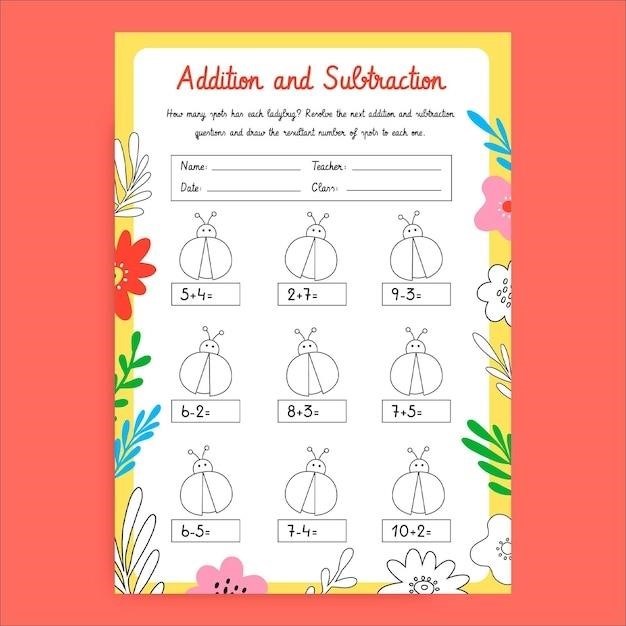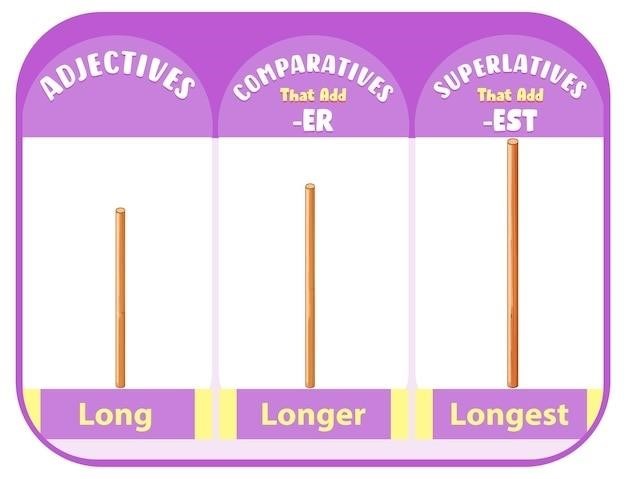This worksheet provides a comprehensive guide to understanding and solving problems related to rational exponents and radicals. It includes practice problems with answer keys to help you master the concepts. The PDF format allows for easy printing and use in classrooms or for individual study. The topics covered include converting between rational exponents and radicals, simplifying expressions with rational exponents, properties of rational exponents, solving equations with rational exponents, and applications of rational exponents and radicals.
Introduction to Rational Exponents and Radicals
This section introduces the fundamental concepts of rational exponents and radicals, laying the groundwork for understanding their relationship and applications in mathematics. Rational exponents represent fractional powers, where the numerator indicates the power to which the base is raised and the denominator indicates the root to be taken. For instance, x1/2 represents the square root of x, while x1/3 denotes the cube root of x. Radicals, on the other hand, provide a notation for expressing roots, with the radical symbol (√) indicating the root to be taken. For example, √x signifies the square root of x. The concept of rational exponents and radicals is crucial for simplifying expressions, solving equations, and tackling various real-world problems.
Understanding the connection between rational exponents and radicals is essential for working with these concepts effectively. The key relationship lies in their ability to represent the same mathematical idea in different forms. A rational exponent, such as xm/n, can be rewritten in radical notation as the nth root of x raised to the power of m, denoted as (√x)m. This equivalence allows for flexibility in choosing the most convenient notation for a given problem.
The introduction of rational exponents and radicals opens up a new realm of mathematical operations and problem-solving techniques. This section provides the foundation for the subsequent topics, equipping you with the necessary understanding to delve deeper into the world of rational exponents and radicals.
Converting Between Rational Exponents and Radicals
The ability to convert between rational exponents and radicals is a fundamental skill in working with these mathematical concepts. This conversion process involves understanding the relationship between the numerator and denominator of the rational exponent and the corresponding radical notation. A rational exponent xm/n represents the nth root of x raised to the power of m, which can be expressed in radical notation as (√x)m. For example, x2/3 can be rewritten as (√x)2, indicating that we are taking the cube root of x and then squaring the result.
The conversion process can be applied in both directions⁚ from rational exponents to radicals and vice versa. When converting from rational exponents to radicals, the denominator of the exponent becomes the index of the radical, and the numerator becomes the exponent of the radicand. Conversely, when converting from radicals to rational exponents, the index of the radical becomes the denominator of the exponent, and the exponent of the radicand becomes the numerator. This ability to seamlessly switch between these two forms allows for flexibility in solving problems and simplifying expressions.
Understanding the conversion process is crucial for applying the properties of rational exponents and radicals. It enables us to manipulate expressions efficiently, simplifying them to their most basic form and making calculations easier. This section provides a clear and concise explanation of the conversion process, equipping you with the necessary tools to confidently navigate between rational exponents and radicals.
Simplifying Expressions with Rational Exponents
Simplifying expressions with rational exponents is an essential skill in algebra and calculus. It involves applying various properties of exponents and radicals to rewrite complex expressions in a more manageable form. These simplifications can make calculations easier, reveal patterns, and facilitate further mathematical operations. One key strategy involves converting between rational exponents and radicals, as discussed in the previous section. This allows us to apply familiar rules for simplifying radicals, such as factoring out perfect squares or cubes.

The properties of exponents play a vital role in simplifying expressions with rational exponents; These properties include the product rule, quotient rule, power rule, and the rule for negative exponents. For example, the product rule states that xm * xn = xm+n, which applies to rational exponents as well. Similarly, the quotient rule, xm / xn = xm-n, and the power rule, (xm)n = xm*n, are equally applicable. By applying these properties systematically, we can simplify expressions by combining terms, eliminating negative exponents, and reducing the complexity of the expression.
Simplifying expressions with rational exponents often involves factoring out common factors and using the properties of exponents to reduce the expression to its simplest form. This section provides a comprehensive guide to simplifying such expressions, equipping you with the tools and techniques to confidently tackle a wide range of problems involving rational exponents.
Properties of Rational Exponents
Understanding the properties of rational exponents is crucial for working with these expressions effectively. These properties are derived from the fundamental rules of exponents and provide a framework for simplifying, manipulating, and solving equations involving rational exponents. The properties extend the familiar rules of integer exponents to include fractional exponents, allowing for a consistent and predictable approach to working with these expressions.

One of the key properties is the product rule⁚ xm * xn = xm+n. This rule applies to both integer and rational exponents, enabling us to combine terms with the same base by adding their exponents. For example, x1/2 * x1/3 = x1/2 + 1/3 = x5/6. Another important property is the quotient rule⁚ xm / xn = xm-n. This rule allows us to simplify expressions by subtracting the exponents of terms with the same base. For instance, x3/4 / x1/4 = x3/4 ー 1/4 = x1/2.
The power rule, (xm)n = xmn, is another fundamental property that applies to both integer and rational exponents. This property allows us to raise a power to another power by multiplying the exponents. For instance, (x1/3)2 = x(1/3) 2 = x2/3. These properties, along with the rule for negative exponents, provide a comprehensive set of tools for simplifying, manipulating, and solving equations involving rational exponents.
Solving Equations with Rational Exponents
Solving equations with rational exponents requires a systematic approach that utilizes the properties of exponents and the concept of inverse operations. The key is to isolate the variable term containing the rational exponent and then apply the appropriate inverse operation to eliminate the exponent. This involves raising both sides of the equation to the reciprocal of the rational exponent, effectively canceling out the exponent and isolating the variable.
For instance, consider the equation x2/3 = 8. To solve for x, we first raise both sides of the equation to the reciprocal of 2/3, which is 3/2. This yields (x2/3)3/2 = 83/2. Applying the power rule, we get x(2/3)(3/2) = 83/2, which simplifies to x = 83/2. Evaluating 83/2 as the square root of 8 cubed, we find that x = 16. This process demonstrates the use of inverse operations and the power rule to solve equations with rational exponents.
It is important to note that when raising both sides of an equation to an even power, we must consider both positive and negative solutions since squaring a negative number results in a positive number. However, if the exponent is odd, we only need to consider the positive solution. This careful consideration of potential solutions ensures that the solution obtained is valid and satisfies the original equation.
Applications of Rational Exponents and Radicals
Rational exponents and radicals find practical applications in various fields, including geometry, physics, and engineering. They are particularly useful in scenarios involving calculations related to volumes, areas, and distances.
In geometry, rational exponents and radicals are applied in calculating the volume and surface area of geometric shapes. For example, the volume of a sphere can be expressed using the formula V = (4/3)πr³, where r is the radius. This formula involves a rational exponent of 3, indicating that the volume is directly proportional to the cube of the radius. Similarly, the surface area of a sphere can be calculated using the formula SA = 4πr², which also involves a rational exponent of 2.
In physics, rational exponents and radicals are used in various formulas, including those related to motion, energy, and electricity. For instance, the kinetic energy of an object is given by KE = (1/2)mv², where m is the mass and v is the velocity. This formula involves a rational exponent of 2, indicating that the kinetic energy is proportional to the square of the velocity.
Engineering applications of rational exponents and radicals are found in areas like structural design, fluid mechanics, and heat transfer. For example, the stress on a beam is calculated using formulas involving rational exponents and radicals, ensuring the structural integrity of buildings and bridges.
These examples highlight the wide range of applications of rational exponents and radicals in various fields, showcasing their importance in solving real-world problems and understanding complex phenomena.
Practice Problems
The practice problems section of a rational exponents and radicals worksheet is designed to reinforce your understanding of the concepts and help you develop your problem-solving skills. These problems typically cover a range of topics, from basic conversions between rational exponents and radicals to more challenging simplification and equation-solving tasks.
Here’s a sample of the types of practice problems you might encounter⁚
- Converting between rational exponents and radicals⁚ Rewrite the expression 5^(1/2) in radical form. Write the radical expression √(27) in exponential form.
- Simplifying expressions with rational exponents⁚ Simplify the expression (x^(2/3)) * (x^(1/4)). Simplify the expression (8^(1/3)) / (2^(1/2)).
- Properties of rational exponents⁚ Use the properties of exponents to simplify the expression (a^(1/2) * b^(1/4))^2. Simplify the expression (x^(3/4) / x^(1/2)).
- Solving equations with rational exponents⁚ Solve the equation x^(1/2) = 4. Solve the equation (x+1)^(2/3) = 9.
- Applications of rational exponents and radicals⁚ A cube has a side length of 5 cm. Find the volume of the cube using the formula V = s³, where s is the side length. A sphere has a radius of 3 cm. Find the surface area of the sphere using the formula SA = 4πr², where r is the radius.
These practice problems are designed to challenge you and help you gain a deeper understanding of the concepts involved. By working through these problems and checking your answers against the provided answer key, you can build confidence in your abilities and prepare yourself for more advanced applications of rational exponents and radicals.
Answer Key
An answer key is an essential component of a rational exponents and radicals worksheet, providing students with the opportunity to check their work and identify areas where they need further practice. The answer key should be comprehensive, providing detailed solutions for each practice problem. This allows students to understand the reasoning behind each step and learn from any mistakes they may have made.
The answer key can be structured in various ways. One common approach is to provide the final answer alongside a step-by-step solution for each problem. This allows students to quickly verify their answer and then study the solution if they need clarification. Another approach is to present the answer key as a separate document, where each problem is listed with its corresponding solution. This format allows students to focus on the solution process without being distracted by the problem statement.
Regardless of the format, the answer key should be clear, concise, and easy to understand. It should also be free of errors to ensure that students are learning the correct concepts. A well-designed answer key can be a valuable tool for students, helping them to learn from their mistakes and improve their understanding of rational exponents and radicals.
Additional Resources
In addition to the worksheet itself, providing supplemental resources can greatly enhance a student’s understanding of rational exponents and radicals. These resources can take various forms, offering different approaches to learning and reinforcing concepts. Online platforms like Khan Academy and YouTube offer comprehensive video tutorials and practice exercises, breaking down complex topics into manageable chunks. Websites dedicated to mathematics education, such as Math Playground and Cool Math, provide interactive games and activities that make learning engaging and fun.
Textbooks and workbooks can provide more in-depth explanations and practice problems, while online forums and communities allow students to connect with peers and educators for support and clarification. Further resources can include interactive simulations that visually demonstrate the concepts of rational exponents and radicals, helping students develop a deeper understanding. Additionally, online calculators specifically designed for working with rational exponents and radicals can be valuable tools for checking answers and exploring different scenarios.
By providing a diverse range of resources, educators can cater to different learning styles and preferences, ensuring that students have access to materials that support their individual needs. This comprehensive approach to learning can significantly enhance a student’s understanding and mastery of rational exponents and radicals.
